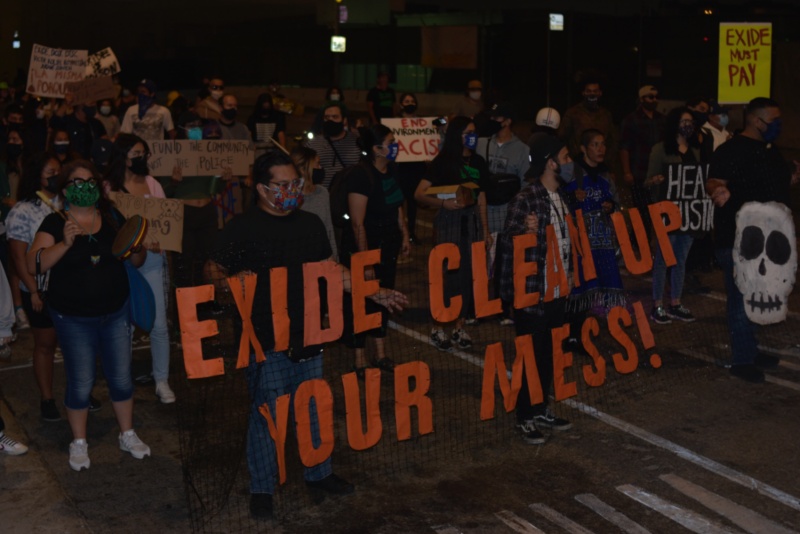By Ashley Orona
Contributing Writer
VERNON — A federal court’s decision Oct. 16 to allow Exide to abandon its contaminated battery-recycling facility — putting taxpayers on the hook for the state’s largest environmental cleanup ever — has been met with outrage from the communities affected by pollution from the plant.
A bankruptcy court approved a plan allowing Exide Holdings Inc. to abandon its battery recycling plant in Vernon before completing environmental cleanup in the neighborhoods it polluted. The move was recommended by the U.S. Department of Justice and leaves California taxpayers responsible for the $270 million operation.
People from at least half a dozen communities have been fighting for years to keep Exide accountable for exposing workers and households in neighborhoods like Boyle Heights, East Los Angeles Commerce and Maywood to dangerous levels of lead. They said that authorities were allowing another corporation to get away with hurting the local community.
“These types of things only happen in low-income communities of color, that’s where people are taking the most advantage,” said Rossmery Zayas, youth organizer for Communities for a Better Environment. “That’s where people are the most vulnerable.”
Exide operated as a battery recycling plant in Vernon for more than 30 years. During that time, it accumulated dozens of waste violations and was cited for emitting too much toxic air pollution while operating. An investigation by the state Department of Toxic Substances Control found that lead concentration in soil near the recycling plant was up to 52,000 parts per million, concentrations over 1,000 parts per million are considered hazardous waste in California.
The pollution exposed the surrounding communities to dangerous levels of cancer-causing arsenic and lead. A South Coast Air Quality Management District Health Risk Assessment of Exide concluded that upwards of 250,000 residents face chronic health hazards from exposure to lead and arsenic emitted from the facility that settled into the soil of residential neighborhoods. Community members mobilized to try and keep Exide accountable.
In 2015, the U.S. Department of Justice entered a non-prosecution agreement with Exide to permanently close the battery recycling facility and pay $50 million to clean up the site and the surrounding neighborhoods.
This past May, Exide Holdings Inc. filed petitions for relief with the U.S. Bankruptcy Court in the state of Delaware. The company claimed to not have the financial ability to continue as an operating business and would be liquidating 17 of its properties in 11 states, if necessary. Exide then entered into court-ordered mediation with the state of California, the U.S. Environmental Protection Agency and other entities.
During mediation, Exide proposed a plan where the facility and cleanup would be transferred to the Environmental Response Trust. The state of California refused to sign on to the plan, which would have resulted in the state receiving $2.6 million in exchange for releasing Exide from liability, according to the Los Angeles Times.
After the state declined to sign on, the court agreed to a plan where Exide would abandon the property and be released from liability. Gov. Gavin Newsom condemned this plan.
Community members also expressed outrage about the decision and the process leading up to it.
“Being that this is California’s biggest lead clean up in its history, it’s really ridiculous to have to try to convince [people] that this needs to be removed from the community,” Zayas of Communities for a Better Environment said.
Two hearings were held last week leading to the decision, one on Oct. 13 where community members were given the opportunity to speak and one on Oct. 15 for a court hearing that was extended to the next day.
Many community members felt that the public process was purposely made to exclude them and claimed that not enough notice was given for these hearings and that the meetings themselves were not accessible.
Zayas said that even with a master’s degree, she was confused by the jargon used in the hearing and that working-class community members likely had trouble understanding the decision made by the court as well.
Despite the barriers, community members mobilized and attended the Oct. 13 hearing where hundreds of comments were made and an additional 570 written comments were submitted. Many residents waited for hours to make a one-minute comment.
Residents protested the decision Oct. 19 beginning at Mariachi Plaza in Boyle Heights and marching to the federal building in downtown Los Angeles.
Ashley Orona is a freelance reporter for Wave Newspapers who covers the East Los Angeles area. She can be reached at Oronash@gmail.com.












